Exercises (2252)
Raising and lowering the arms alternately while standing ► steering wheel
Power
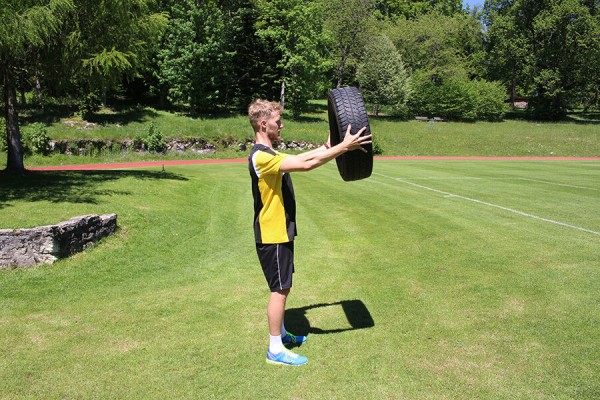
Stand upright, hold an object (e.g. rucksack, weighted disc or tyre) with your arms almost outstretched in front of your body at chest height, move your arms up and down alternately like you would steer a car (tilt the object to either side).
Attention:
Tighten your stomach, straighten your back, stabilise your shoulders (push towards your hips).
Lighten:
Less weight/load; raise your arms less (lower chest height).
Harden:
More weight/greater load.
1 weight disc/(medicine) ball/fighting backpack/tyre (PUCH)
1 helmet/1-2 PET bottles (1.5) litres ► Make the exercise easier
1 sandbag ► Make the exercise more difficult (additional weight)
Raising and lowering the arms alternately while standing ► steering wheel
Power
Individual work
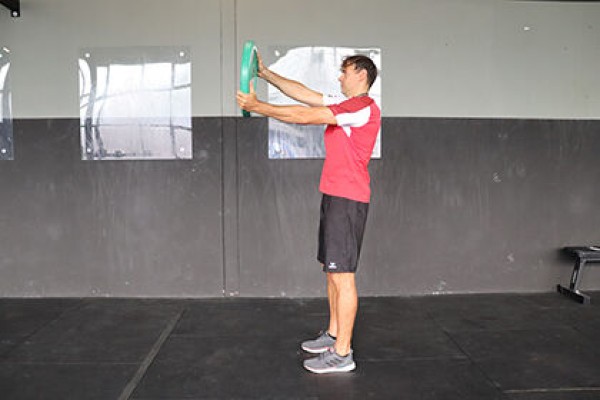
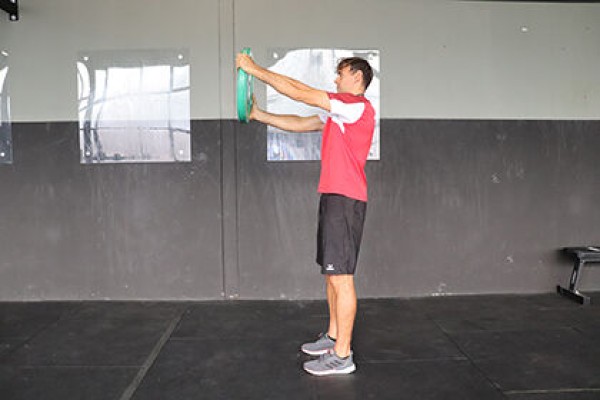
Stand upright, hold the weight disc in front of your body at chest height with your arms almost outstretched, move your arms up and down alternately/oppositely as you would steer a car.
Attention:
Tighten your stomach, keep your back straight, stabilise your shoulders (push towards your hips).
Lighten:
Less weight; raise your arms less (lower chest height).
Harden:
More weight.
Variation:
Move both arms slightly up and down in parallel.
1 weight disc
Raising and lowering of the arms in prone position ► prone A
Power
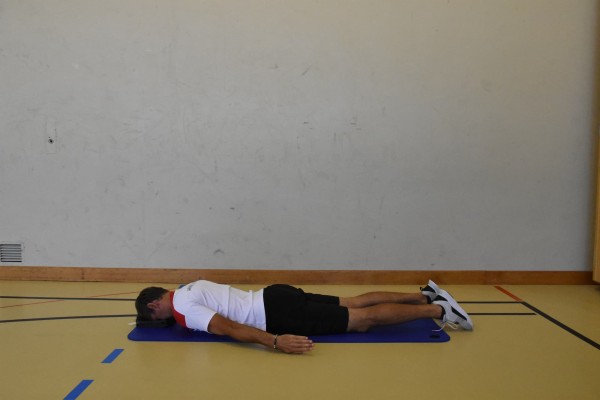
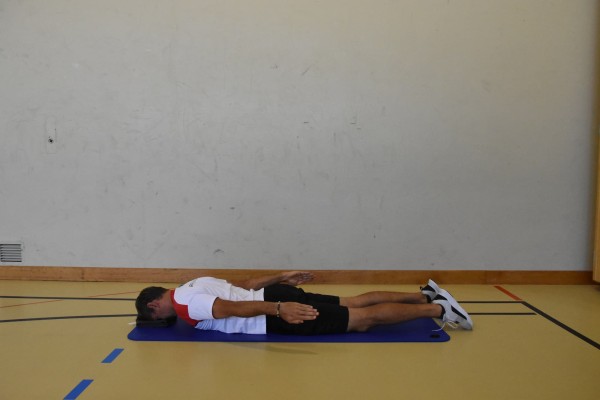
Lying on your stomach with your forehead resting on a folded cloth, feet shoulder-width apart, arms pointing diagonally backwards (A position) in extension of the body to each side. Arms stretched and completely relaxed. From this position, pull the shoulder blades together and raise the arms until the elbows are at shoulder height and the arms are parallel to the floor (palms facing inwards). Keep your arms straight throughout the entire movement. Exhale in the end position, hold the position for a moment, then inhale and lower your arms back to the starting position.
Attention:
Only the arms should be raised, nothing else - aim to isolate the upper back.
Harden:
Do not lower your arms completely; hold additional weight in your hands or on your arms.
Variation I:
Alternately raise one arm (instead of both at the same time).
Variation II:
Position on a flat bench or an incline bench.
2 weight cuffs/2 weight balls/dumbbells ► Make the exercise more difficult (additional weight)
Raising and lowering of the arms in prone position ► prone A raise
Power
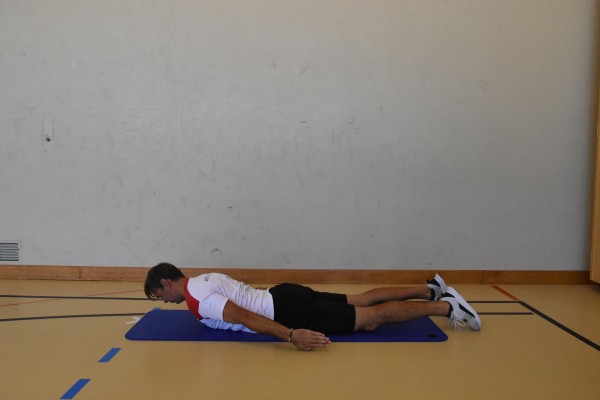
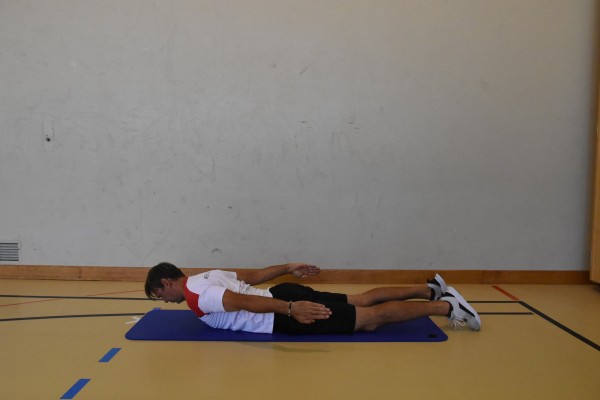
Prone position with upper body slightly raised, feet shoulder-width apart, arms pointing diagonally backwards (A position) in extension of the body to each side. Arms stretched and completely relaxed. From this position, pull the shoulder blades together and raise the arms until the elbows are at shoulder height and the arms are parallel to the floor (palms facing inwards). Keep your arms straight throughout the entire movement. Exhale in the end position, hold the position for a moment, then inhale and lower your arms back to the starting position.
Attention:
Only the arms should be raised, nothing else - aim to isolate the upper back.
Harden:
Do not lower your arms completely; hold additional weight in your hands or on your arms.
Variation I:
Alternately raise one arm (instead of both at the same time).
Variation II:
Position on a flat bench or an incline bench.
2 weight cuffs/2 weight balls/dumbbells ► Make the exercise more difficult (additional weight)
Raising and lowering of the arms in prone position ► prone I
Power
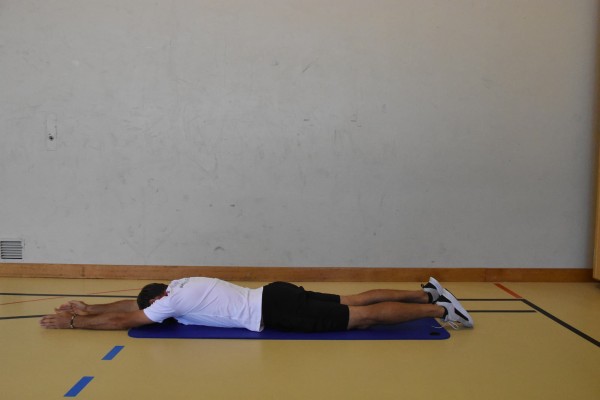
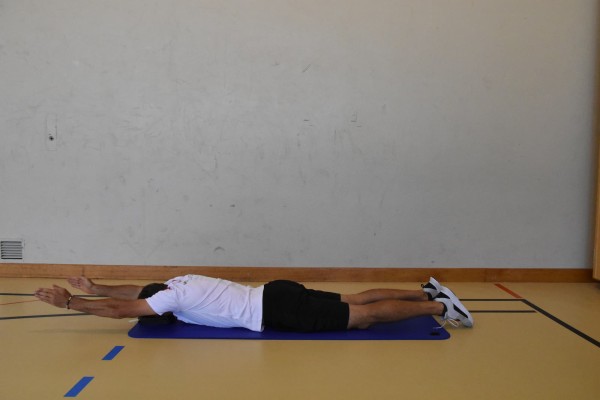
Lying on your stomach with your forehead resting on a folded cloth, feet shoulder-width apart, arms pointing forwards in extension of the body (I position). Arms stretched and completely relaxed. From this position, pull the shoulder blades together and raise the arms until the elbows are at shoulder height and the arms are parallel to the floor (palms facing inwards). Keep your arms straight throughout the entire movement. Exhale in the end position, hold the position for a moment, then inhale and lower your arms back to the starting position.
Attention:
Only the arms should be raised, nothing else - aim to isolate the upper back.
Harden:
Do not lower your arms completely; hold additional weight in your hands or on your arms.
Variation I:
Alternately raise one arm (instead of both at the same time).
Variation II:
Position on a flat bench or an incline bench.
2 weight cuffs/2 weight balls/dumbbells ► Make the exercise more difficult (additional weight)
Raising and lowering of the arms in prone position ► prone I raise
Power
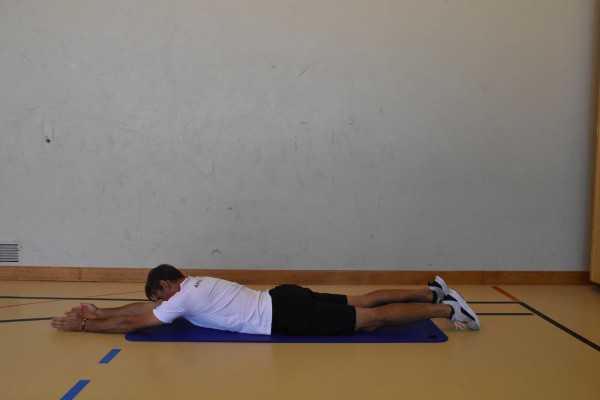

Prone position with upper body slightly raised, feet shoulder-width apart, arms pointing forwards in extension of the body (I position). Arms stretched and completely relaxed. From this position, pull the shoulder blades together and raise the arms until the elbows are at shoulder height and the arms are parallel to the floor (palms facing inwards). Keep your arms straight throughout the entire movement. Exhale in the end position, hold the position for a moment, then inhale and lower your arms back to the starting position.
Attention:
Only the arms should be raised, nothing else - aim to isolate the upper back.
Harden:
Do not lower your arms completely; hold additional weight in your hands or on your arms.
Variation I:
Alternately raise one arm (instead of both at the same time).
Variation II:
Position on a flat bench or an incline bench.
2 weight cuffs/2 weight balls/dumbbells ► Make the exercise more difficult (additional weight)
Raising and lowering of the arms in prone position ► prone weighted A
Power
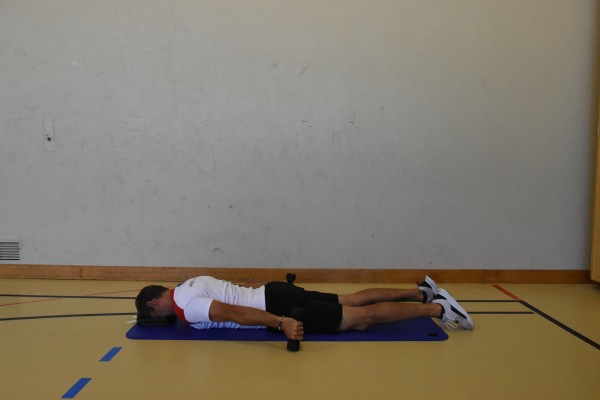
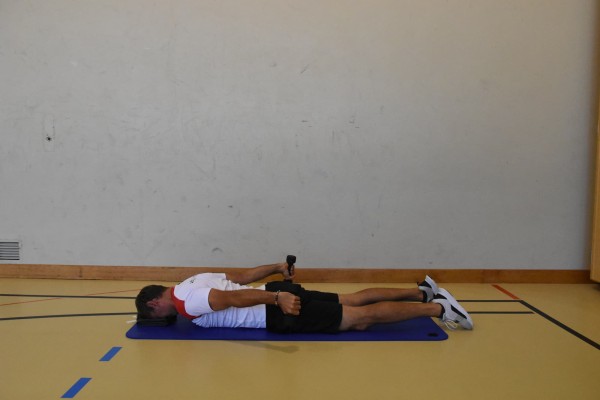
Lying on your stomach with your forehead resting on a folded cloth, feet shoulder-width apart, arms pointing diagonally backwards (A position) in extension of the body to each side. Arms stretched and completely relaxed. Hold a (light) dumbbell in each hand. From this position, pull the shoulder blades together and raise the arms until the elbows are at shoulder height and the arms are parallel to the floor (palms facing inwards). Keep your arms straight throughout the entire movement. Exhale in the end position, hold the position for a moment, then inhale and lower your arms back to the starting position.
Attention:
Only the arms should be raised, nothing else - aim to isolate the upper back.
Harden:
Do not lower your arms completely.
Variation I:
Alternately raise one arm (instead of both at the same time).
Variation II:
Position on a flat bench or an incline bench.
2 weight cuffs/2 weight balls/dumbbells
Raising and lowering of the arms in prone position ► prone weighted A raise
Power
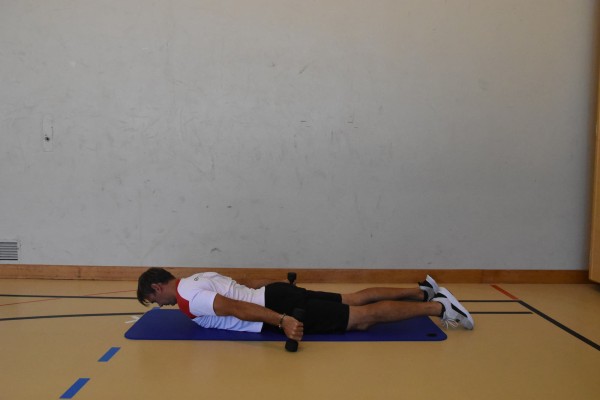
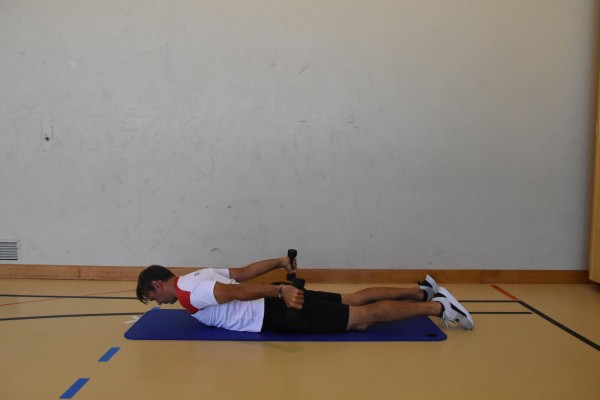
Prone position with upper body slightly raised, feet shoulder-width apart, arms pointing diagonally backwards (A position) in extension of the body to each side. Arms stretched and completely relaxed. Hold a (light) dumbbell in each hand. From this position, pull the shoulder blades together and raise the arms until the elbows are at shoulder height and the arms are parallel to the floor (palms facing inwards). Keep your arms straight throughout the entire movement. Exhale in the end position, hold the position for a moment, then inhale and lower your arms back to the starting position.
Attention:
Only the arms should be raised, nothing else - aim to isolate the upper back.
Harden:
Do not lower your arms completely.
Variation I:
Alternately raise one arm (instead of both at the same time).
Variation II:
Position on a flat bench or an incline bench.
2 weight cuffs/2 weight balls/dumbbells
Raising and lowering of the arms in prone position ► prone weighted I
Power
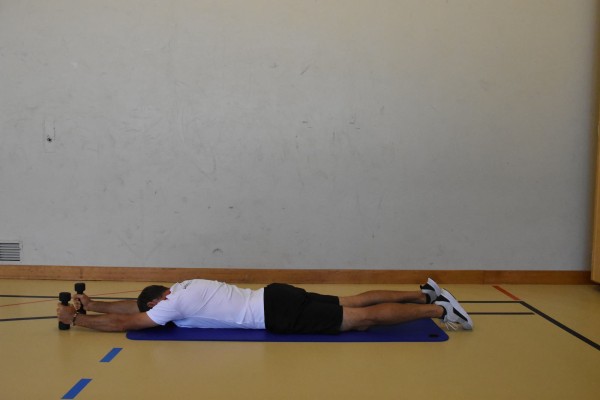
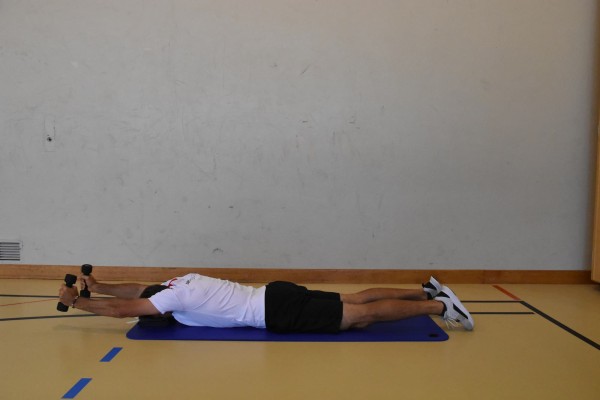
Lying on your stomach with your forehead resting on a folded cloth, feet shoulder-width apart, arms pointing forwards in extension of the body (I position). Arms stretched and completely relaxed. Hold a (light) dumbbell in each hand. From this position, pull the shoulder blades together and raise the arms until the elbows are at shoulder height and the arms are parallel to the floor (palms facing inwards). Keep your arms straight throughout the entire movement. Exhale in the end position, hold the position for a moment, then inhale and lower your arms back to the starting position.
Attention:
Only the arms should be raised, nothing else - aim to isolate the upper back.
Harden:
Do not lower your arms completely.
Variation I:
Alternately raise one arm (instead of both at the same time).
Variation II:
Position on a flat bench or an incline bench.
2 weight cuffs/2 weight balls/dumbbells
Raising and lowering of the arms in prone position ► prone weighted I raise
Power
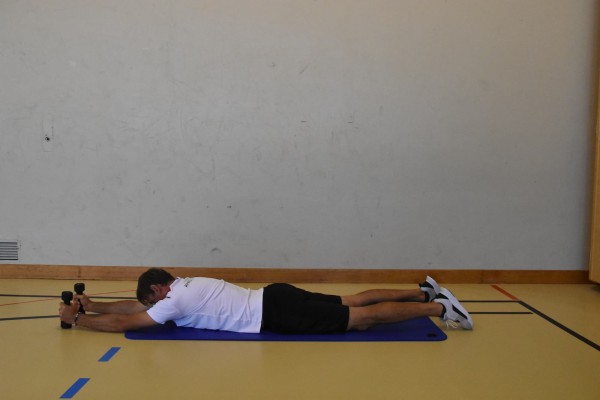
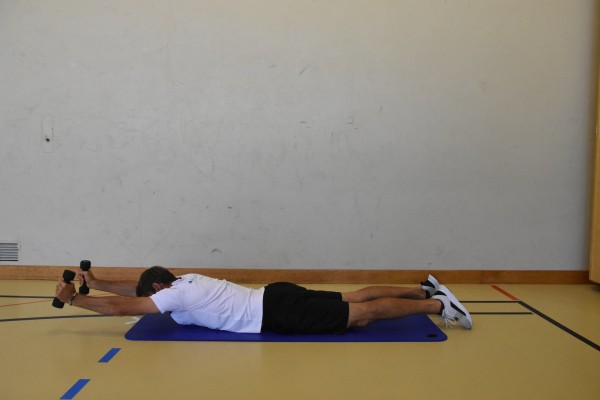
Prone position with upper body slightly raised, feet shoulder-width apart, arms pointing forwards in extension of the body (I position). Arms stretched and completely relaxed. Hold a (light) dumbbell in each hand. From this position, pull the shoulder blades together and raise the arms until the elbows are at shoulder height and the arms are parallel to the floor (palms facing inwards). Keep your arms straight throughout the entire movement. Exhale in the end position, hold the position for a moment, then inhale and lower your arms back to the starting position.
Attention:
Only the arms should be raised, nothing else - aim to isolate the upper back.
Harden:
Do not lower your arms completely.
Variation I:
Alternately raise one arm (instead of both at the same time).
Variation II:
Position on a flat bench or an incline bench.
2 weight cuffs/2 weight balls/dumbbells
Raising and lowering of the arms in prone position ► prone weighted Y
Power
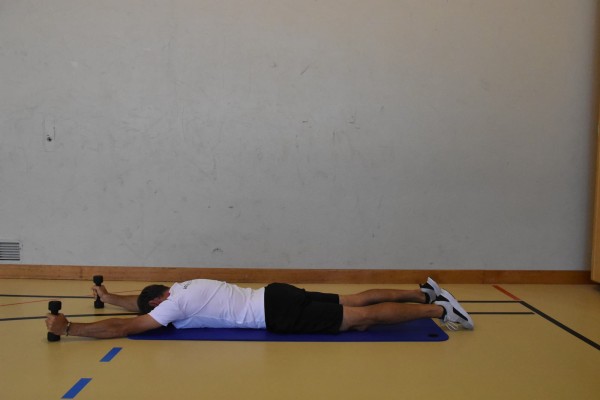
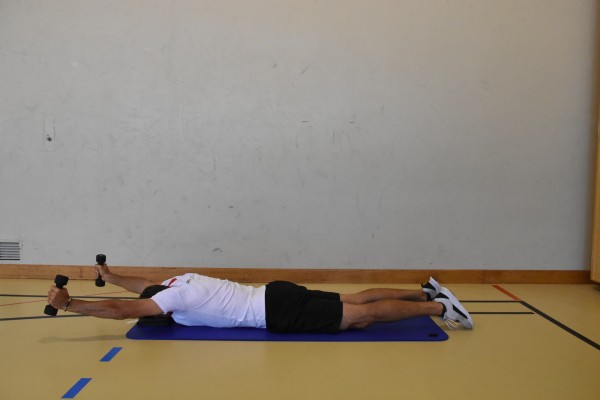
Lying on your stomach with your forehead resting on a folded cloth, feet shoulder-width apart, arms pointing diagonally forwards (Y position) in extension of the body to each side. Arms stretched and completely relaxed. Hold a (light) dumbbell in each hand. From this position, pull the shoulder blades together and raise the arms until the elbows are at shoulder height and the arms are parallel to the floor (palms facing inwards). Keep your arms straight throughout the entire movement. Exhale in the end position, hold the position for a moment, then inhale and lower your arms back to the starting position.
Attention:
Only the arms should be raised, nothing else - aim to isolate the upper back.
Harden:
Do not lower your arms completely.
Variation I:
Alternately raise one arm (instead of both at the same time).
Variation II:
Position on a flat bench or an incline bench.
2 weight cuffs/2 weight balls/dumbbells
Raising and lowering of the arms in prone position ► prone weighted Y raise
Power
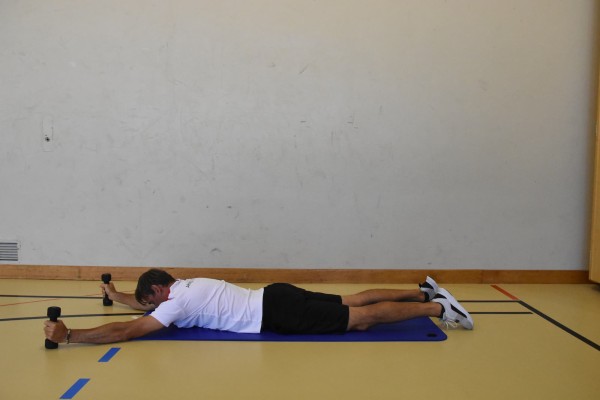
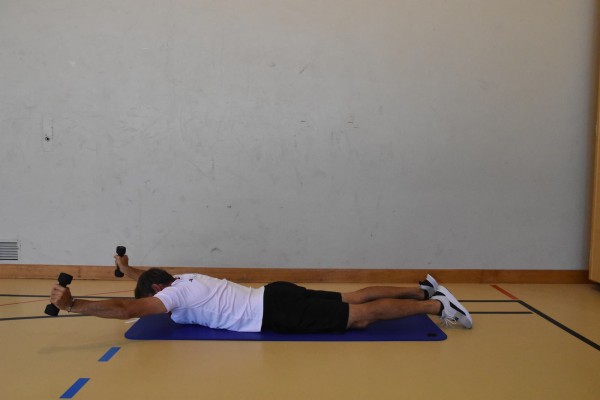
Prone position with upper body slightly raised, feet shoulder-width apart, arms pointing diagonally forwards (Y position) in extension of the body to each side. Arms stretched and completely relaxed. Hold a (light) dumbbell in each hand. From this position, pull the shoulder blades together and raise the arms until the elbows are at shoulder height and the arms are parallel to the floor (palms facing inwards). Keep your arms straight throughout the entire movement. Exhale in the end position, hold the position for a moment, then inhale and lower your arms back to the starting position.
Attention:
Only the arms should be raised, nothing else - aim to isolate the upper back.
Harden:
Do not lower your arms completely.
Variation I:
Alternately raise one arm (instead of both at the same time).
Variation II:
Position on a flat bench or an incline bench.
2 weight cuffs/2 weight balls/dumbbells
Raising and lowering of the arms in prone position ► prone weighted YTWAI/YTW/YTI/YTWI/YTAI
Power




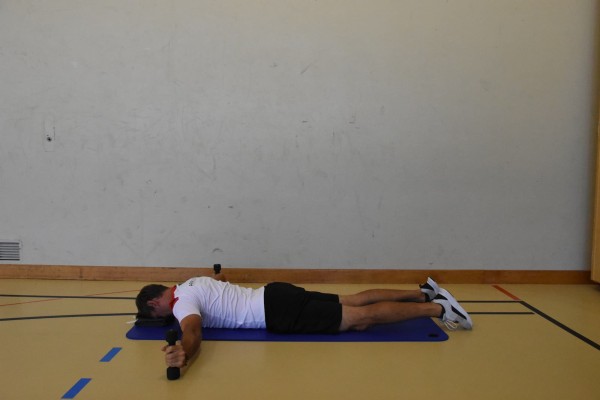
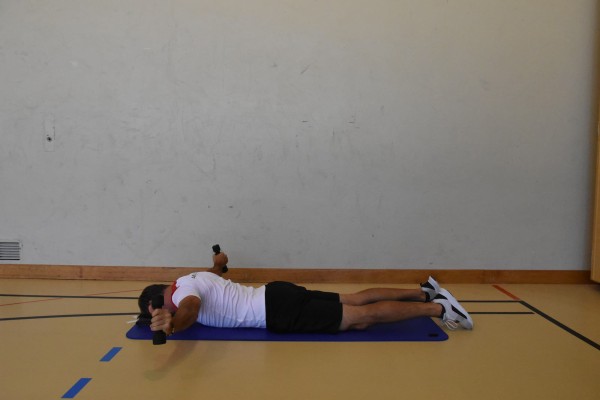
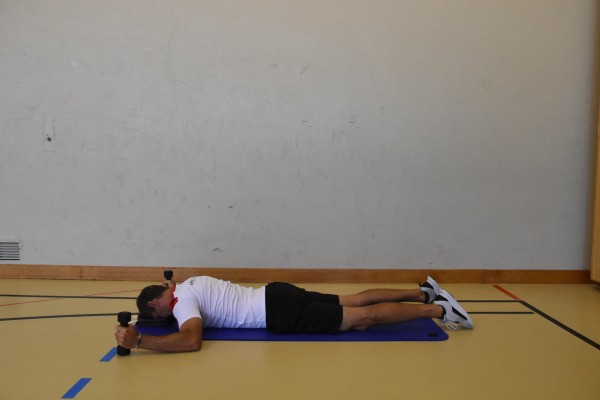
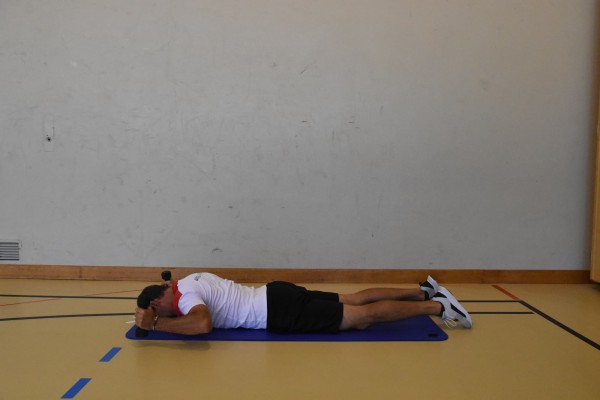


Lie on your stomach with your forehead resting on a folded cloth, arms completely relaxed on the floor, hold a (light) dumbbell in each hand, feet shoulder-width apart. From various starting positions, pull the shoulder blades together and raise the arms until the elbows are at shoulder height and the arms are parallel to the floor. Exhale in the end position, hold the position for a moment, then inhale and lower your arms back to the starting position.
Starting positions:
I-position: Arms point forwards in extension of the body (palms facing inwards)
Y-position: Arms point diagonally forwards in extension of the body to the respective side (palms facing inwards)
T-position: Arms pointing to the respective side (palms facing forwards or downwards)
W-position: arms bent, elbows close to the body, arms pointing diagonally forwards to the respective side (palms facing diagonally inwards)
A-position: arms pointing diagonally backwards in extension of the body to the respective side (palms facing inwards)
Possible sequences (examples):
YTWAI
YTW
YTI
YTWI
YTAI
Attention:
Only the arms should be raised, nothing else - aim to isolate the upper back.
Harden:
Do not lower your arms completely; hold additional weight in your hands or on your arms.
Variation I:
Alternately raise one arm (instead of both at the same time).
Variation II:
Position on a flat bench or an incline bench.
2 weight cuffs/2 weight balls/dumbbells
Raising and lowering of the arms in prone position ► prone weighted YTWAI/YTW/YTI/YTWI/YTAI raise
Power




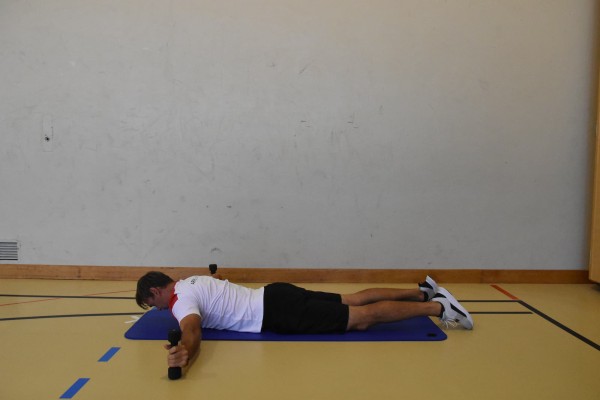
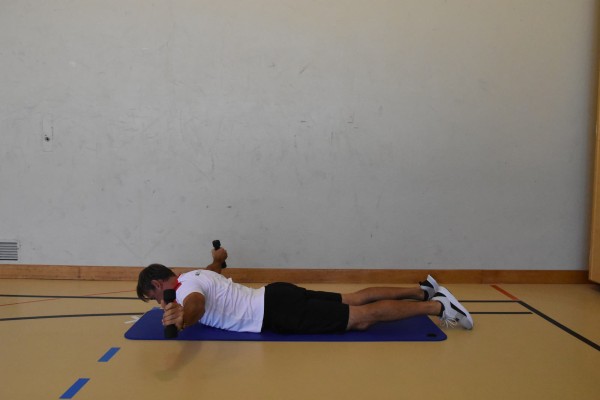
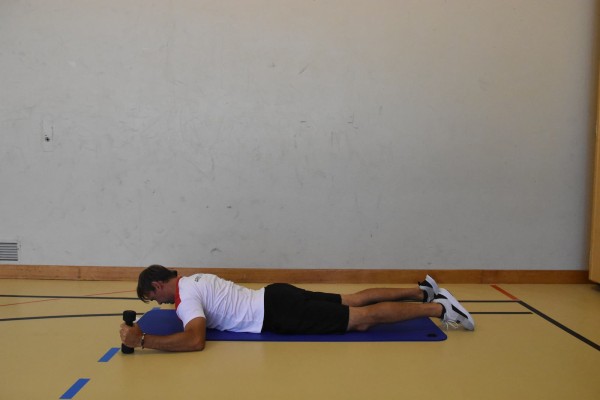
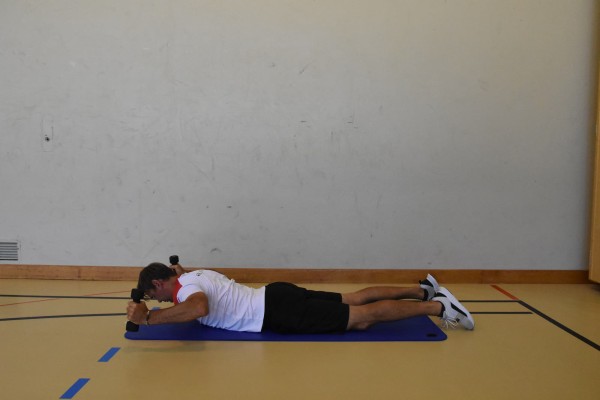


Prone position with upper body slightly raised, arms completely relaxed on the floor, hold a (light) dumbbell in each hand, feet shoulder-width apart. From various starting positions, pull the shoulder blades together and raise the arms until the elbows are at shoulder height and the arms are parallel to the floor. Exhale in the end position, hold the position for a moment, then inhale and lower your arms back to the starting position.
Starting positions:
I-position: Arms point forwards in extension of the body (palms facing inwards)
Y-position: Arms point diagonally forwards in extension of the body to the respective side (palms facing inwards)
T-position: Arms pointing to the respective side (palms facing forwards or downwards)
W-position: arms bent, elbows close to the body, arms pointing diagonally forwards to the respective side (palms facing diagonally inwards)
A-position: arms pointing diagonally backwards in extension of the body to the respective side (palms facing inwards)
Possible sequences (examples):
YTWAI
YTW
YTI
YTWI
YTAI
Attention:
Only the arms should be raised, nothing else - aim to isolate the upper back.
Harden:
Do not lower your arms completely; hold additional weight in your hands or on your arms.
Variation I:
Alternately raise one arm (instead of both at the same time).
Variation II:
Position on a flat bench or an incline bench.
2 weight cuffs/2 weight balls/dumbbells ► Make the exercise more difficult (additional weight)
Raising and lowering of the arms in prone position ► prone Y
Power
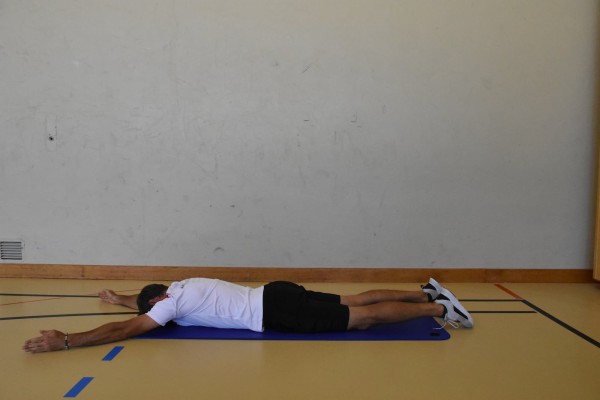
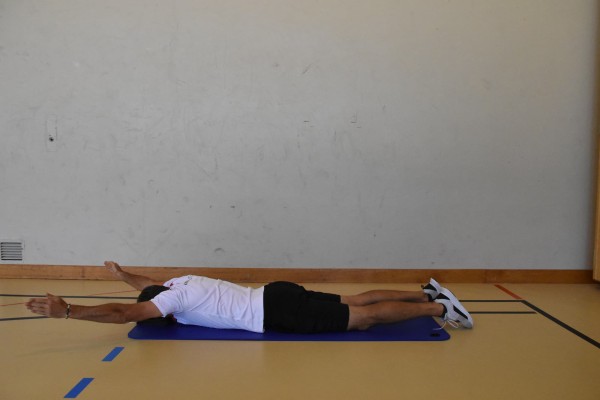
Lying on your stomach with your forehead resting on a folded cloth, feet shoulder-width apart, arms pointing diagonally forwards (Y position) in extension of the body to each side. Arms stretched and completely relaxed. From this position, pull the shoulder blades together and raise the arms until the elbows are at shoulder height and the arms are parallel to the floor (palms facing inwards). Keep your arms straight throughout the entire movement. Exhale in the end position, hold the position for a moment, then inhale and lower your arms back to the starting position.
Attention:
Only the arms should be raised, nothing else - aim to isolate the upper back.
Harden:
Do not lower your arms completely; hold additional weight in your hands or on your arms.
Variation I:
Alternately raise one arm (instead of both at the same time).
Variation II:
Position on a flat bench or an incline bench.
2 weight cuffs/2 weight balls/dumbbells ► Make the exercise more difficult (additional weight)
Raising and lowering of the arms in prone position ► prone Y raise
Power
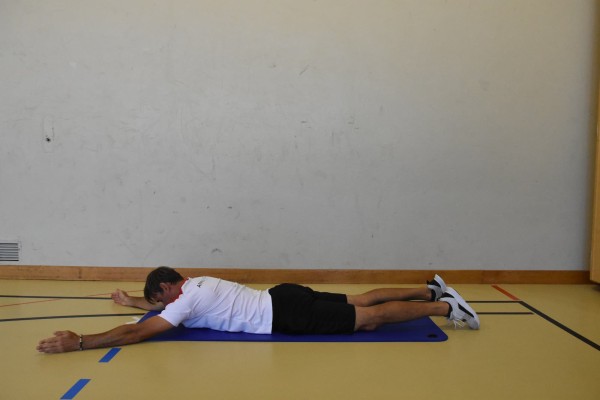
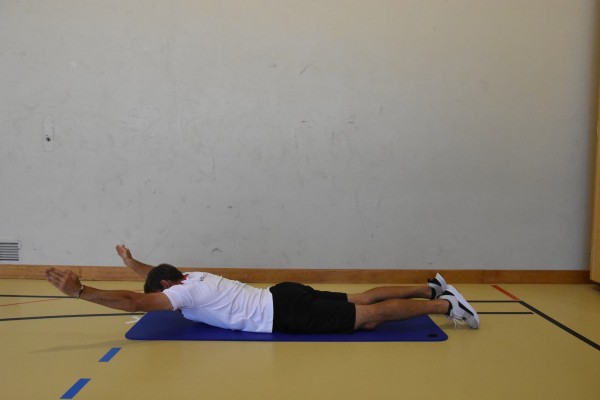
Prone position with upper body slightly raised, feet shoulder-width apart, arms pointing diagonally forwards (Y position) in extension of the body to each side. Arms stretched and completely relaxed. From this position, pull the shoulder blades together and raise the arms until the elbows are at shoulder height and the arms are parallel to the floor (palms facing inwards). Keep your arms straight throughout the entire movement. Exhale in the end position, hold the position for a moment, then inhale and lower your arms back to the starting position.
Attention:
Only the arms should be raised, nothing else - aim to isolate the upper back.
Harden:
Do not lower your arms completely; hold additional weight in your hands or on your arms.
Variation I:
Alternately raise one arm (instead of both at the same time).
Variation II:
Position on a flat bench or an incline bench.
2 weight cuffs/2 weight balls/dumbbells ► Make the exercise more difficult (additional weight)
Raising and lowering of the arms in prone position ► prone YTWAI/YTW/YTI/YTWI/YTAI
Power




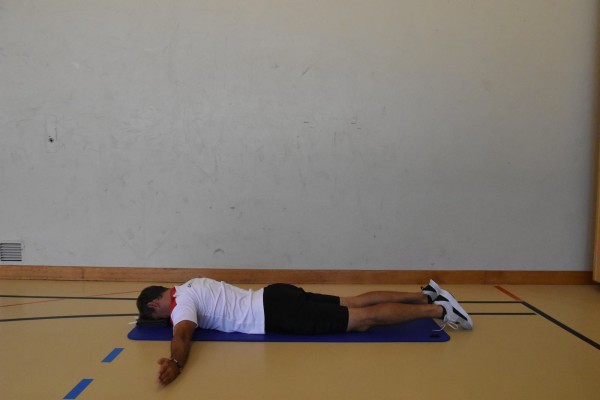
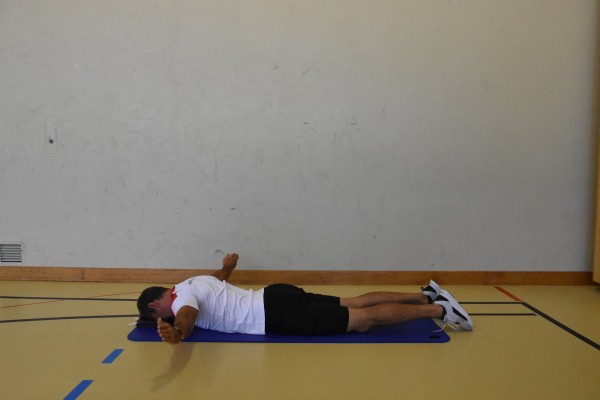
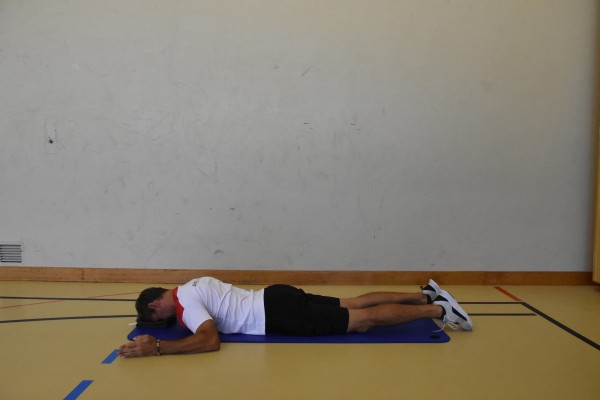
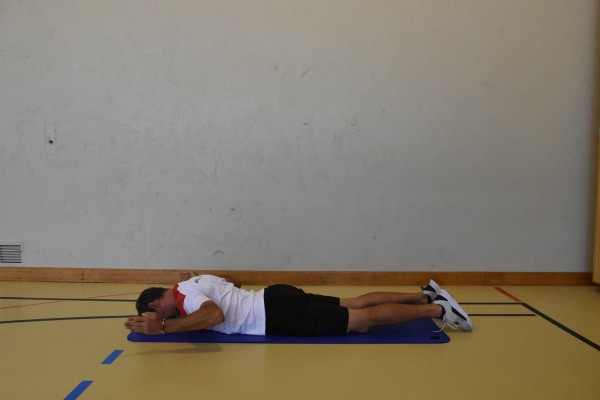


Lie on your stomach with your forehead resting on a folded cloth, arms completely relaxed on the floor, feet shoulder-width apart. From various starting positions, pull the shoulder blades together and raise the arms until the elbows are at shoulder height and the arms are parallel to the floor. Exhale in the end position, hold the position for a moment, then inhale and lower your arms back to the starting position.
Starting positions:
I-position: Arms point forwards in extension of the body (palms facing inwards)
Y-position: Arms point diagonally forwards in extension of the body to the respective side (palms facing inwards)
T-position: Arms pointing to the respective side (palms facing forwards or downwards)
W-position: arms bent, elbows close to the body, arms pointing diagonally forwards to the respective side (palms facing diagonally inwards)
A-position: arms pointing diagonally backwards in extension of the body to the respective side (palms facing inwards)
Possible sequences (examples):
YTWAI
YTW
YTI
YTWI
YTAI
Attention:
Only the arms should be raised, nothing else - aim to isolate the upper back.
Harden:
Do not lower your arms completely; hold additional weight in your hands or on your arms.
Variation I:
Alternately raise one arm (instead of both at the same time).
Variation II:
Position on a flat bench or an incline bench.
2 weight cuffs/2 weight balls/dumbbells ► Make the exercise more difficult (additional weight)
Raising and lowering of the arms in prone position ► prone YTWAI/YTW/YTI/YTWI/YTAI raise
Power




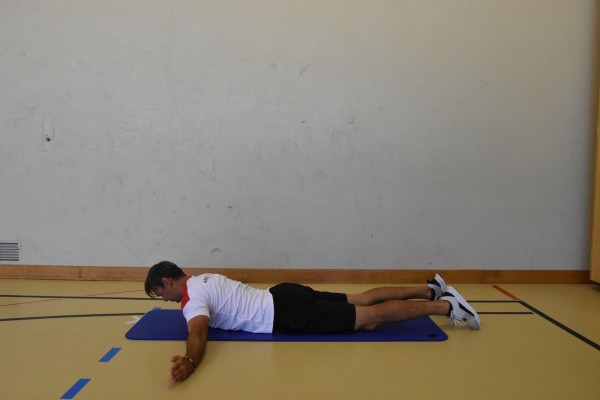
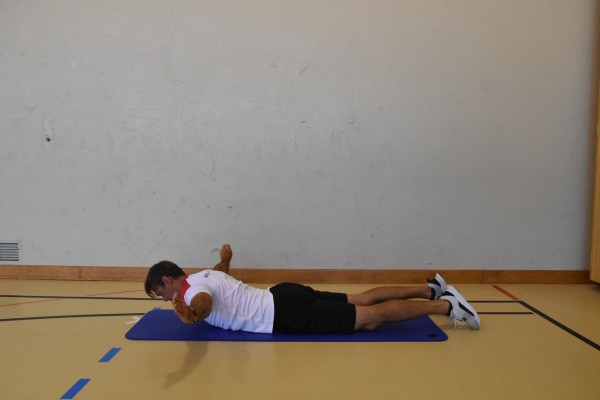
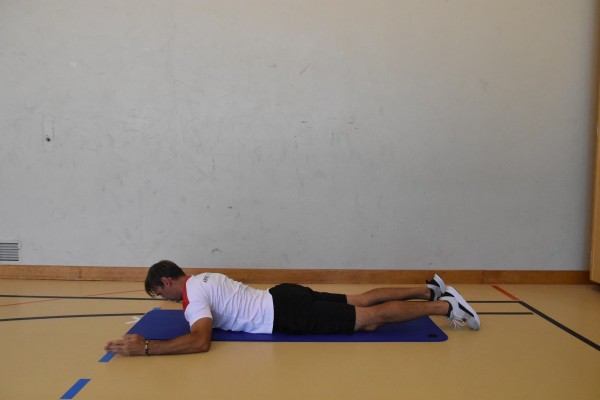
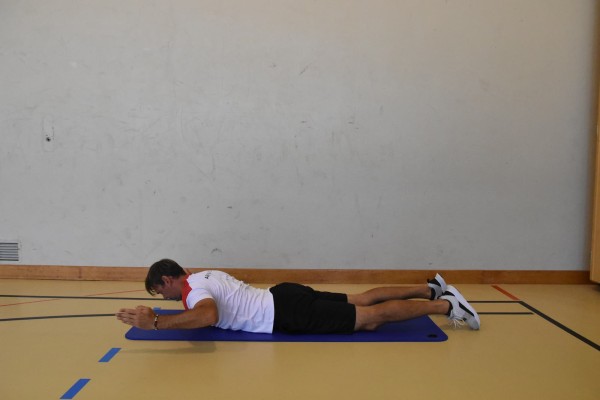


Prone position with upper body slightly raised, arms completely relaxed on the floor, feet shoulder-width apart. From various starting positions, pull the shoulder blades together and raise the arms until the elbows are at shoulder height and the arms are parallel to the floor. Exhale in the end position, hold the position for a moment, then inhale and lower your arms back to the starting position.
Starting positions:
I-position: Arms point forwards in extension of the body (palms facing inwards)
Y-position: Arms point diagonally forwards in extension of the body to the respective side (palms facing inwards)
T-position: Arms pointing to the respective side (palms facing forwards or downwards)
W-position: arms bent, elbows close to the body, arms pointing diagonally forwards to the respective side (palms facing diagonally inwards)
A-position: arms pointing diagonally backwards in extension of the body to the respective side (palms facing inwards)
Possible sequences (examples):
YTWAI
YTW
YTI
YTWI
YTAI
Attention:
Only the arms should be raised, nothing else - aim to isolate the upper back.
Harden:
Do not lower your arms completely; hold additional weight in your hands or on your arms.
Variation I:
Alternately raise one arm (instead of both at the same time).
Variation II:
Position on a flat bench or an incline bench.
2 weight cuffs/2 weight balls/dumbbells ► Make the exercise more difficult (additional weight)
Raising and lowering the arms in a negative supine position ► decline fly
Power
Individual work

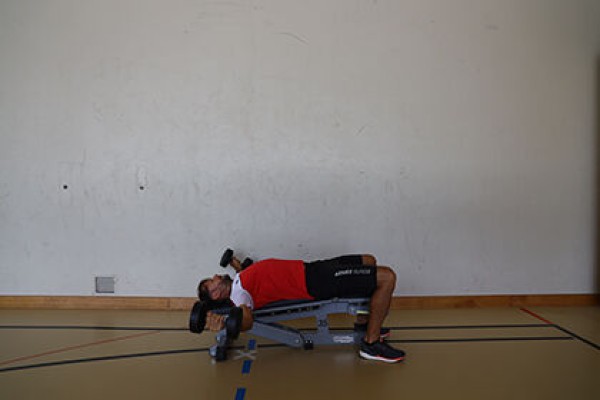
Sit on your back on the flat bench in a negative position, i.e. pointing downwards at an angle (decline) (head closer to the floor than the legs). The arms are almost stretched out to the respective side (approximately horizontal to the floor), a dumbbell is held in each hand with the palms facing upwards. Bring your arms, which are always almost straight, together in front of your chest (holding position). Then lower your arms (weights) back to the starting position in a controlled manner (the movement creates a semi-circle, so to speak).
Attention:
Do not fully extend your arms, keep your elbows in front of your shoulders (do not bring the dumbbells fully together).
Lighten:
Less weight (no additional weight).
Harden:
More weight.
Variation:
Bench in a straight/flat position (flat bench) or in an inclined position with the seat facing upwards (incline).
1 flat bench
2 dumbbells
Raising and lowering the arms in supine position ► fly
Power
Individual work
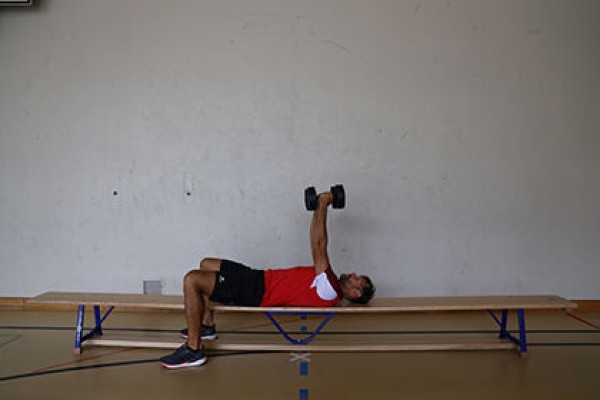
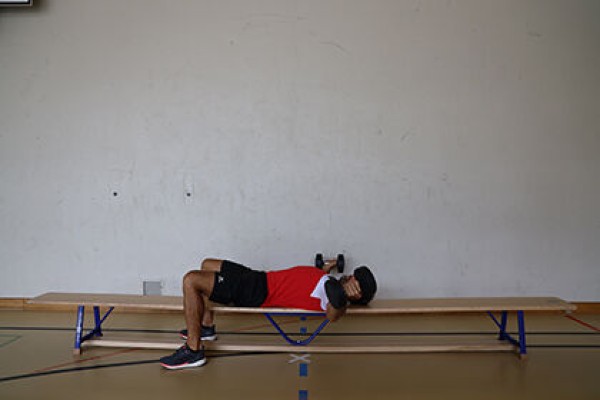
Lie on your back on the long bench with your arms almost stretched out to your sides (roughly horizontal to the floor), holding a dumbbell in each hand with the palms facing upwards. Bring your arms, which are always almost straight, together in front of your chest (holding position). Then lower your arms (weights) back to the starting position in a controlled manner (the movement creates a semi-circle, so to speak).
Attention:
Do not fully extend your arms, keep your elbows in front of your shoulders (do not bring the dumbbells fully together).
Lighten:
Less weight (no additional weight).
Harden:
More weight.
1 long bench
2 dumbbells
Raising and lowering the arms in supine position ► fly
Power
Individual work
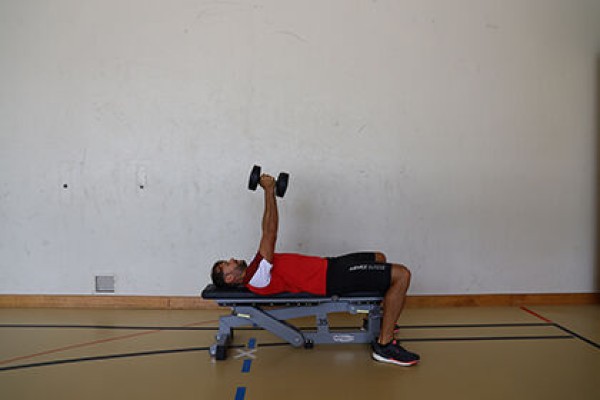
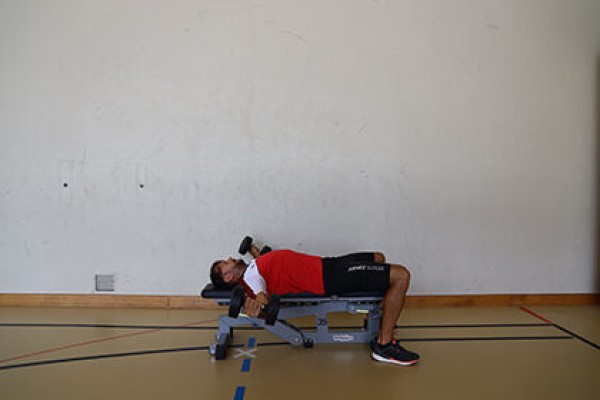
Lie on your back on the flat bench (straight/flat position), arms pointing almost outstretched to either side (roughly horizontal to the floor), holding a dumbbell in each hand with the palms facing upwards. Bring your arms, which are always almost straight, together in front of your chest (holding position). Then lower your arms (weights) back to the starting position in a controlled manner (the movement creates a semi-circle, so to speak).
Attention:
Do not fully extend your arms, keep your elbows in front of your shoulders (do not bring the dumbbells fully together).
Lighten:
Less weight (no additional weight).
Harden:
More weight.
Variation:
An incline bench or even a decline bench.
1 flat bench
2 dumbbells
Raising and lowering the arms in supine position ► fly
Power
Individual work
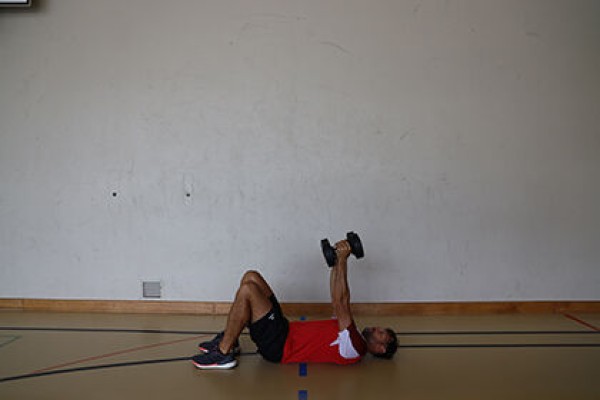
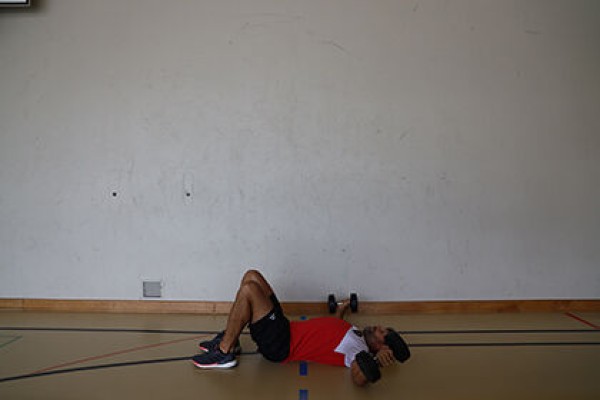
Lie on your back on the floor (legs may be upright), arms almost stretched out to either side (upper arms practically resting on the floor, forearms pointing slightly upwards at an angle), holding a dumbbell in each hand with the palms facing upwards. Bring your arms, which are always almost straight, together in front of your chest (holding position). Then lower your arms (weights) back to the starting position in a controlled manner (the movement creates a semi-circle, so to speak).
Attention:
Do not fully extend your arms, keep your elbows in front of your shoulders (do not bring the dumbbells fully together).
Lighten:
Less weight (no additional weight).
Harden:
More weight.
2 dumbbells
Raising and lowering the arms in supine position ► pull over
Power
Partner work
1 trainee & 1 helper ► Note change of position
(= double the time required; for lesson planner see Organisation Kraft: Info button Execution)
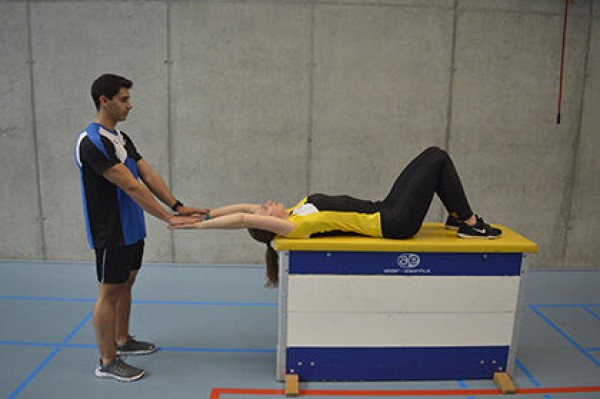
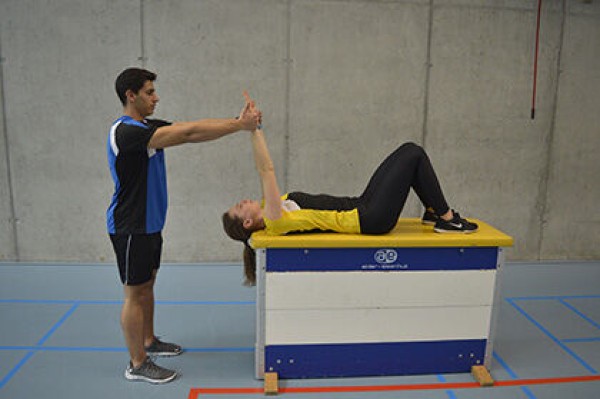
Trainee: Lying on their back on the swing box (lengthways), legs bent, head resting on the end of the swing box, arms stretched horizontally upwards (held high), raise arms to the holding position (facing forwards) and return to the starting position.
Partner: Stand by the outstretched arms of the active participant, grasp their hands and hold against the movement.
Attention:
Always listen to/respond to your partner (adjust pressure/intensity). No hollow back.
Lighten:
Less resistance/pressure from your partner.
Harden:
More resistance/pressure from your partner; additional weight (hold in your hands).
1 vaulting box (2-3 elements incl. top)
1 weight ball/weight disc/dumbbell/sandbag ► Make the exercise more difficult (additional weight)
Raising and lowering the arms in an inclined supine position ► decline fly
Power
Individual work
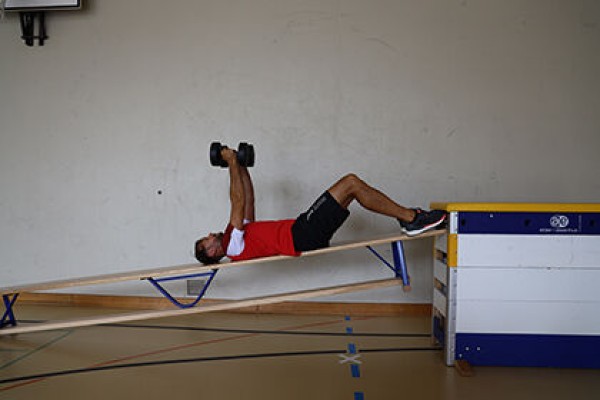
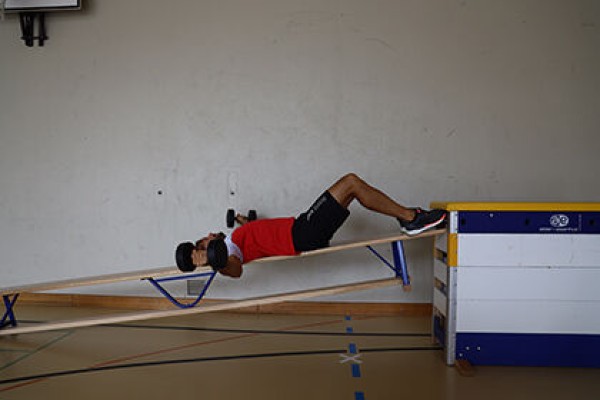
Lie on your back on the inclined long bench (long bench attached to the Swedish box or wall bars) with your head closer to the floor than your legs (legs may be attached to the box or wall bars). The arms are almost stretched out to each side (approximately horizontal to the floor), a dumbbell is held in each hand with the palms facing upwards. Bring your arms, which are always almost straight, together in front of your chest (holding position). Then lower your arms (weights) back to the starting position in a controlled manner (the movement creates a semi-circle, so to speak).
Attention:
Do not fully extend your arms, keep your elbows in front of your shoulders (do not bring the dumbbells fully together).
Lighten:
Less weight (no additional weight).
Harden:
More weight.
1 vaulting box or wall bars
1 long bench
2 dumbbells
Raising and lowering the arms in an inclined supine position ► incline fly
Power
Individual work
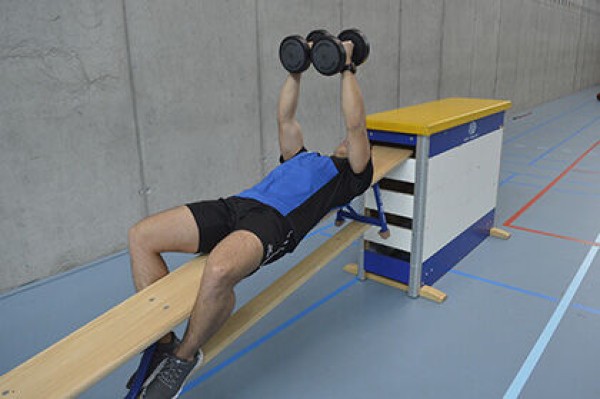
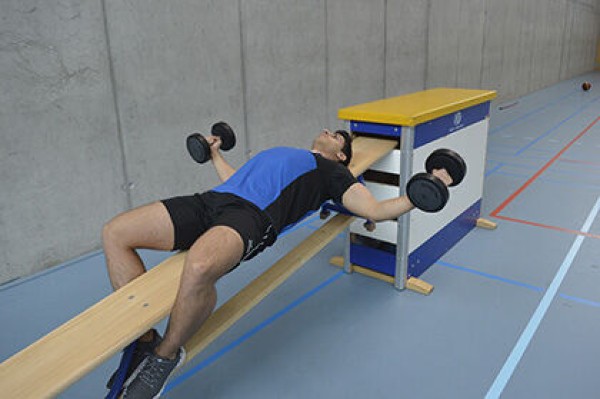
Lie on your back on the inclined long bench (long bench attached to the vaulting box or wall bars), arms pointing almost straight out to the respective side (roughly horizontal to the floor), holding a dumbbell in each hand with the palms facing upwards. Bring your arms, which are always almost straight, together in front of your chest (holding position). Then lower your arms (weights) back to the starting position in a controlled manner (the movement creates a semi-circle, so to speak).
Attention:
Do not fully extend your arms, keep your elbows in front of your shoulders (do not bring the dumbbells fully together).
Lighten:
Less weight (no additional weight).
Harden:
More weight.
1 vaulting box or wall bars
1 long bench
2 dumbbells